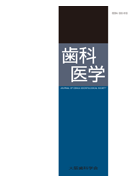Volume 75, Issue 2
Displaying 1-33 of 33 articles from this issue
- |<
- <
- 1
- >
- >|
-
Article type: Article
2012 Volume 75 Issue 2 Pages 59-64
Published: September 25, 2012
Released on J-STAGE: June 08, 2017
Download PDF (14666K) -
Article type: Article
2012 Volume 75 Issue 2 Pages 65-69
Published: September 25, 2012
Released on J-STAGE: June 08, 2017
Download PDF (7756K) -
Article type: Article
2012 Volume 75 Issue 2 Pages 70-75
Published: September 25, 2012
Released on J-STAGE: June 08, 2017
Download PDF (13213K) -
Article type: Article
2012 Volume 75 Issue 2 Pages 76-80
Published: September 25, 2012
Released on J-STAGE: June 08, 2017
Download PDF (7598K)
-
Article type: Article
2012 Volume 75 Issue 2 Pages B17-B18
Published: September 25, 2012
Released on J-STAGE: June 08, 2017
Download PDF (235K) -
Article type: Article
2012 Volume 75 Issue 2 Pages B19-B20
Published: September 25, 2012
Released on J-STAGE: June 08, 2017
Download PDF (234K) -
Article type: Article
2012 Volume 75 Issue 2 Pages B21-B22
Published: September 25, 2012
Released on J-STAGE: June 08, 2017
Download PDF (272K) -
Article type: Article
2012 Volume 75 Issue 2 Pages B23-B24
Published: September 25, 2012
Released on J-STAGE: June 08, 2017
Download PDF (233K) -
Article type: Article
2012 Volume 75 Issue 2 Pages B24-B25
Published: September 25, 2012
Released on J-STAGE: June 08, 2017
Download PDF (249K) -
Article type: Article
2012 Volume 75 Issue 2 Pages B26-B27
Published: September 25, 2012
Released on J-STAGE: June 08, 2017
Download PDF (228K) -
Article type: Article
2012 Volume 75 Issue 2 Pages B28-B29
Published: September 25, 2012
Released on J-STAGE: June 08, 2017
Download PDF (228K) -
Article type: Article
2012 Volume 75 Issue 2 Pages B30-B31
Published: September 25, 2012
Released on J-STAGE: June 08, 2017
Download PDF (240K) -
Article type: Article
2012 Volume 75 Issue 2 Pages B32-B33
Published: September 25, 2012
Released on J-STAGE: June 08, 2017
Download PDF (231K) -
Article type: Article
2012 Volume 75 Issue 2 Pages B34-B35
Published: September 25, 2012
Released on J-STAGE: June 08, 2017
Download PDF (209K) -
Article type: Article
2012 Volume 75 Issue 2 Pages B36-B37
Published: September 25, 2012
Released on J-STAGE: June 08, 2017
Download PDF (237K) -
Article type: Article
2012 Volume 75 Issue 2 Pages B37-B39
Published: September 25, 2012
Released on J-STAGE: June 08, 2017
Download PDF (351K) -
Article type: Article
2012 Volume 75 Issue 2 Pages B39-B41
Published: September 25, 2012
Released on J-STAGE: June 08, 2017
Download PDF (366K) -
Article type: Article
2012 Volume 75 Issue 2 Pages B41-B42
Published: September 25, 2012
Released on J-STAGE: June 08, 2017
Download PDF (251K) -
Article type: Article
2012 Volume 75 Issue 2 Pages B43-B44
Published: September 25, 2012
Released on J-STAGE: June 08, 2017
Download PDF (233K) -
Article type: Article
2012 Volume 75 Issue 2 Pages B44-B45
Published: September 25, 2012
Released on J-STAGE: June 08, 2017
Download PDF (228K) -
Bioactivity of nanostructure on titanium surface modified by chemical processing at room temperatureArticle type: Article
2012 Volume 75 Issue 2 Pages B46-B47
Published: September 25, 2012
Released on J-STAGE: June 08, 2017
Download PDF (238K) -
Article type: Article
2012 Volume 75 Issue 2 Pages B47-B48
Published: September 25, 2012
Released on J-STAGE: June 08, 2017
Download PDF (216K) -
Article type: Article
2012 Volume 75 Issue 2 Pages B49-B50
Published: September 25, 2012
Released on J-STAGE: June 08, 2017
Download PDF (235K) -
Article type: Article
2012 Volume 75 Issue 2 Pages B51-B52
Published: September 25, 2012
Released on J-STAGE: June 08, 2017
Download PDF (244K) -
Article type: Article
2012 Volume 75 Issue 2 Pages B52-B53
Published: September 25, 2012
Released on J-STAGE: June 08, 2017
Download PDF (215K) -
Article type: Article
2012 Volume 75 Issue 2 Pages B54-B55
Published: September 25, 2012
Released on J-STAGE: June 08, 2017
Download PDF (247K) -
Article type: Article
2012 Volume 75 Issue 2 Pages B55-B56
Published: September 25, 2012
Released on J-STAGE: June 08, 2017
Download PDF (276K) -
Article type: Article
2012 Volume 75 Issue 2 Pages B57-B58
Published: September 25, 2012
Released on J-STAGE: June 08, 2017
Download PDF (254K) -
Article type: Article
2012 Volume 75 Issue 2 Pages B58-B59
Published: September 25, 2012
Released on J-STAGE: June 08, 2017
Download PDF (223K) -
Article type: Article
2012 Volume 75 Issue 2 Pages B60-B61
Published: September 25, 2012
Released on J-STAGE: June 08, 2017
Download PDF (226K) -
Article type: Article
2012 Volume 75 Issue 2 Pages B61-B62
Published: September 25, 2012
Released on J-STAGE: June 08, 2017
Download PDF (261K) -
Article type: Article
2012 Volume 75 Issue 2 Pages B63-B64
Published: September 25, 2012
Released on J-STAGE: June 08, 2017
Download PDF (237K) -
Article type: Article
2012 Volume 75 Issue 2 Pages B64-B65
Published: September 25, 2012
Released on J-STAGE: June 08, 2017
Download PDF (243K)
- |<
- <
- 1
- >
- >|
